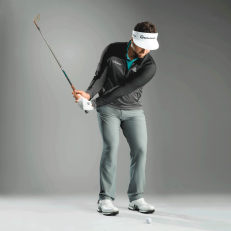Swing Sequence: Jon Rahm

Photo By: J.D. Cuban
Photo By: Photo by J.D. Cuban
Examine the swings of the game's biggest hitters and you'll see the vast majority have two similarities: (1) a big backswing with the left arm bending at the top; (2) the club travelling a long way back to the ball to gather more clubhead speed.But that's not how Jon Rahm cranks drives more than 320 yards. And he does that a lot."He's a big, strong man with incredible athletic power," says Golf Digest 50 Best Teacher Randy Smith. "He keeps that left arm straight and smashes the ball with swing width, not length. Not many can do that."Rahm's clubhead speed (119 miles per hour) is a big reason he's ranked in the top five of the tour's Strokes Gained/Off-the-Tee statistic. It's also probably no coincidence that he's No. 3 in the World Golf Ranking."The positions you see here are so good, they look posed," Smith says. "He uses his physique and strength to make a simple swing. It's like a bigger, harder version of Henrik Stenson's swing. Jon hits it so simple and so square, it's easy to see why his career is on the rise." — Matthew Rudy
Photo By: J.D. Cuban
PRO-FILE: JON RAHM
AGE: 23 / 6-2 / 220 pounds
LIVES: Scottsdale
DRIVER: TaylorMade M4(9.5 degrees)
BALL: TaylorMade TP5X
Photo By: Photo by J.D. Cuban
Jon's swing is generic starting out, says Golf Digest 50 Best Teacher Randy Smith. "At address, the left shoulder and hip are higher than the right side, so he can hit it high and hard," Smith says. "And for a big guy, he looks balanced and comfortable, not feeling any stress."
Photo By: Photo by J.D. Cuban
Jon's chest and arms are moving together—a must for a stronger player. "If his arms went quicker around him, his chest would have to sync up later. That's a recipe for a huge miss," Smith says. Instead, his chest supports the arms. Also, his lower body is quiet. He's winding against it, Smith says.
Photo By: Photo by J.D. Cuban
Look at the distance between his hands and sternum when his left arm is parallel to the ground in the backswing. "Jon's hands have moved a little, but the shaft has moved a lot," Smith says. The club will feel super light like this. If the arms are too close to the body, it feels much heavier."
Photo By: Photo by J.D. Cuban
"The left hip and knee are moving at the target as his upper body is finishing the backswing," Smith says. "And his head has moved off the ball minimally—which is unbelievable, and great for control. He's so strong, he doesn't need a long backswing. It's wide, and I'll take wide over long any day."
Photo By: Photo by J.D. Cuban
As he swings into the ball, his left shoulder moves almost straight up, his left leg is pushing hard, and his hips are returning in sync with the arms. "It's a total power release," Smith says. "His head is actually moving backward. It isn't locked or swaying forward. Both can drain power."
Photo By: Photo by J.D. Cuban
Most players fake extension. They're trying so hard to extend the club toward the target in the through-swing, they forget to put a hit on the ball, Smith says. Jon extended the club as a result of momentum from his fast swing. "This is a totally relaxed effort," Smith says. "He's not gripping tight at all."
Photo By: Photo by J.D. Cuban
"I love the soft, folded arms and supportive feet as he finishes," Smith says. "But what stands out is that Jon's chest has turned at least 90 degrees relative to the target line. There doesn't appear to be any tension. And he finishes in balance despite swinging extremely fast. That's hard to do."






*](http://golfdigest.sports.sndimg.com/content/dam/images/golfdigest/fullset/2015/08/19/55d4e7f34759c60c0823a01c_golfworld-2013-04-gwsl15-adam-scott.jpg.rend.hgtvcom.231.231.suffix/1573516816105.jpeg)









